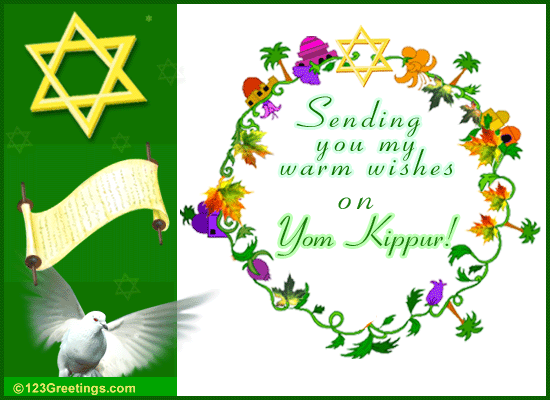Yom Kippur, also known as the Day of Atonement, is the holiest day in Judaism. It is a time for reflection, prayer, and repentance, observed with a 25-hour period of fasting and intensive prayer. The holiday concludes the Ten Days of Repentance that begin with Rosh Hashanah, the Jewish New Year. Given its significance, understanding the appropriate greetings and their meanings can enrich our participation in or appreciation of this solemn occasion. This article delves into the traditions and etiquette surrounding Yom Kippur greetings, offering insights for both Jewish and non-Jewish readers.
The Significance of Yom Kippur
Before examining the greetings associated with Yom Kippur, it is crucial to understand the day’s significance. Yom Kippur is observed on the 10th day of the Hebrew month of Tishrei. It is a day set aside for atonement and reconciliation with God. Jews believe that God inscribes each person’s fate for the coming year in the Book of Life during Rosh Hashanah and seals these verdicts on Yom Kippur, based on their actions and repentance. The day involves abstaining from food and drink, work, and other physical needs, focusing instead on prayer and reflection.
Traditional Yom Kippur Greetings
“Gmar Chatima Tova”
The most traditional greeting for Yom Kippur is “Gmar Chatima Tova,” which translates to “May you be sealed in the Book of Life for a good year.” This greeting is rooted in the belief mentioned above regarding the sealing of one’s fate on Yom Kippur. It is a wish for a positive judgment and a good year ahead, reflecting the day’s focus on atonement and God’s judgment.
“Yom Tov”
While “Yom Tov” is a greeting used for Jewish holidays in general, meaning “Good Day” or “Good Holiday,” its use on Yom Kippur is somewhat more subdued due to the solemnity of the day. It acknowledges the holiday aspect without detracting from the day’s serious nature.
“Tzom Kal”
“Tzom Kal” means “an easy fast” and is commonly used as a way to wish someone well over Yom Kippur. Recognizing the challenge of the 25-hour fast, this greeting is a way to express empathy and support for those observing the fast.
Etiquette and Considerations
Timing
Greetings for Yom Kippur are typically shared in the days leading up to Yom Kippur or on the holiday itself before the fasting begins. It’s also common to wish someone a “Gmar Chatima Tova” towards the end of the fast, looking forward to the breaking of the fast and the conclusion of the holiday.
Audience
While these greetings are deeply rooted in Jewish tradition, non-Jewish individuals can also use them when addressing Jewish friends, colleagues, or acquaintances during Yom Kippur. Doing so is a sign of respect and acknowledgment of the significance of the holiday to the Jewish community.
Sensitivity
Given the solemn nature of Yom Kippur, it’s essential to approach greetings with sensitivity. Recognize that this is a day of introspection, repentance, and renewal for those observing it. The greetings are not just casual well-wishes but convey deep respect for the individual’s commitment to their faith and the observance of this sacred day.
The Cultural and Spiritual Impact of Yom Kippur Greetings
Yom Kippur greetings play a significant role in the cultural and spiritual life of the Jewish community. They are a means of connecting with one another, sharing in the communal aspect of repentance and atonement, and reinforcing the bonds within the community. Moreover, these greetings serve as reminders of the day’s significance, encouraging reflection and introspection among those observing the holiday.
For non-Jews, understanding and using Yom Kippur greetings appropriately is an opportunity to show respect for Jewish traditions and contribute to a culture of mutual respect and understanding. It’s a small but meaningful gesture that can have a positive impact on interfaith relationships.
Conclusion
Yom Kippur is a day of profound spiritual significance, observed with solemnity and deep reflection. The greetings associated with this holiday – “Gmar Chatima Tova,” “Yom Tov,” and “Tzom Kal” – are imbued with wishes for atonement, renewal, and well-being. Understanding the traditions and etiquette surrounding these greetings allows us to participate more fully in the holiday, whether we are observing it ourselves or wishing to show respect and support for those who are. As we extend these greetings, we contribute to a culture of empathy, respect, and mutual understanding, values that are especially poignant in the context of Yom Kippur’s call for introspection and renewal.
FAQs on Yom Kippur Greetings
1. What is the most appropriate greeting for Yom Kippur?
The most traditional and appropriate greeting for Yom Kippur is “Gmar Chatima Tova,” which means “May you be sealed in the Book of Life for a good year.” This greeting reflects the essence of Yom Kippur, focusing on atonement and the hope for a favorable judgment.
2. Can I say “Happy Yom Kippur”?
It is not customary to say “Happy Yom Kippur” due to the solemn nature of the day. Yom Kippur is a day of fasting, prayer, and repentance, which does not align with the sentiment of “happiness.” Instead, use greetings like “Gmar Chatima Tova” or “Tzom Kal” (an easy fast).
3. Is it okay for non-Jews to use Yom Kippur greetings?
Yes, it is perfectly acceptable and appreciated for non-Jews to use Yom Kippur greetings when addressing their Jewish friends, colleagues, or acquaintances. It shows respect and understanding for the significance of the holiday.

